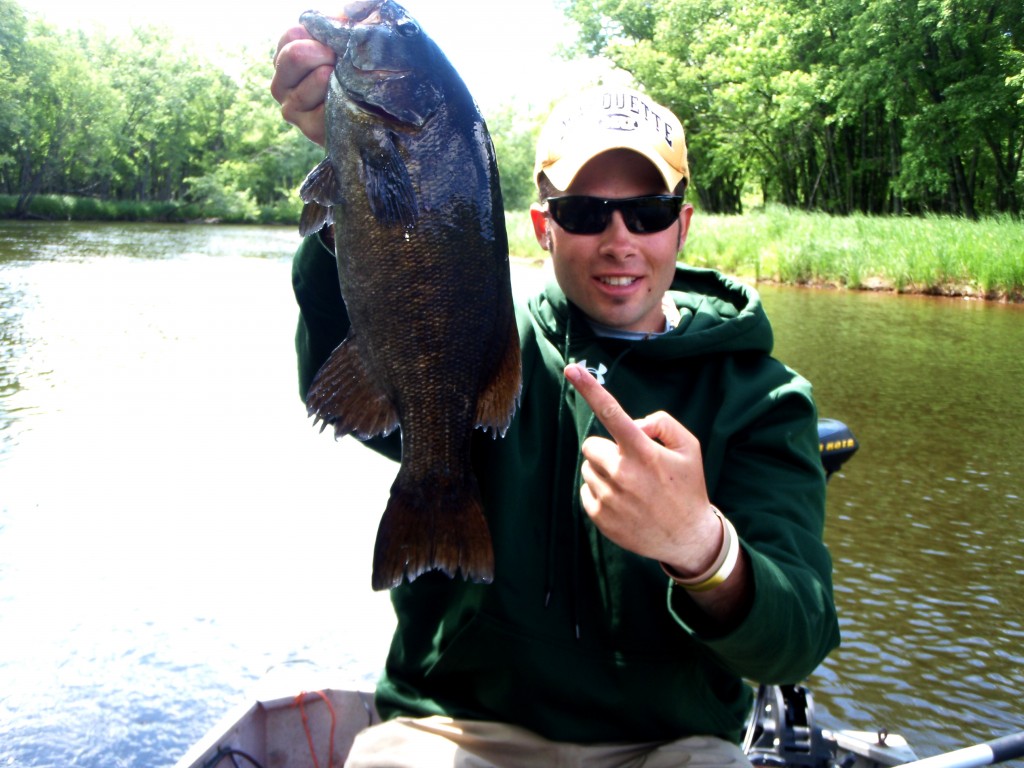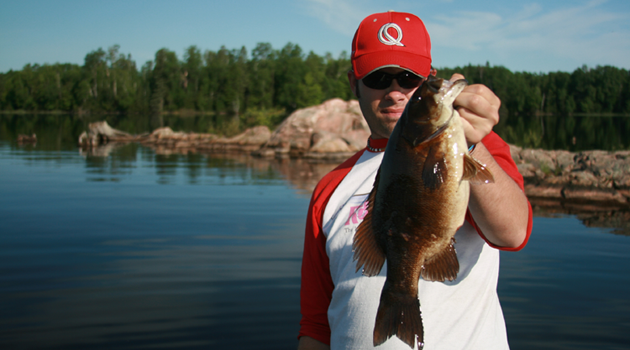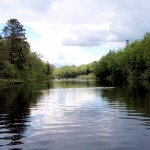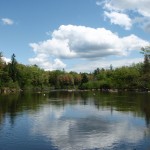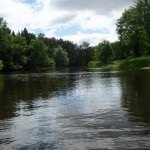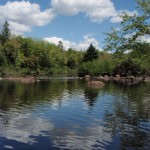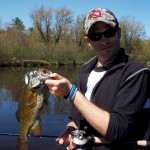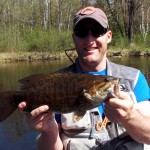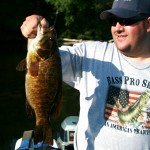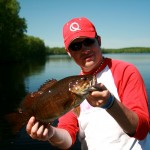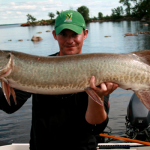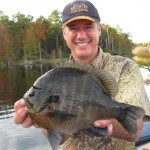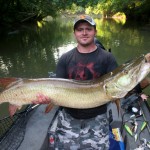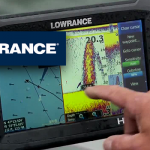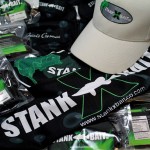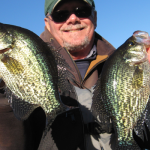By Andrew Ragas
Bass anglers sometimes wonder why certain rivers of Wisconsin’s flowage belt fish best in spring and go unproductive in summer. Understanding the dynamics and little-studied stream migrations between river and reservoir smallmouth bass will help answer these questions.
Throughout my evolvement as a northwoods bass angler, questions have emerged, often pertaining to the biology of certain fisheries and the movements of certain species. One that often arises is the question of fish migration, especially on the major river systems and their corresponding flowages scattered throughout the Northern and Central regions of Wisconsin.
Ten years ago, when I began exploring this region and its many river miles for smallmouth bass, I never understood why some of my favorite pools and sections of the Wisconsin River were most productive during the months of May and June and then went dormant and nearly devoid of fish as the summer weeks progressed. Despite successfully floating and wading them for many miles, and regardless of the excellent habitat and locations I was fishing throughout the year, I could never understand why these stream smallmouth were in abundance EVERYWHERE during one season and not for three others. Considering I’m always fishing somewhere in between two flowages, and within 5 to 10 miles from either one, the educated angler would think that fish should always be in the area regardless of season.
I knew that biology had played a role in my early season fishing locations and success. But like the majority of the angling population, I didn’t realize exactly how much. In recent years, I’ve been able to pattern some Wisconsin rivers and tributaries and make unique seasonal observations about them concerning smallmouth bass migrations. I think I finally solved my own question and figured it out. As the year progresses, I believe this knowledge will lead to more catching and less floating.
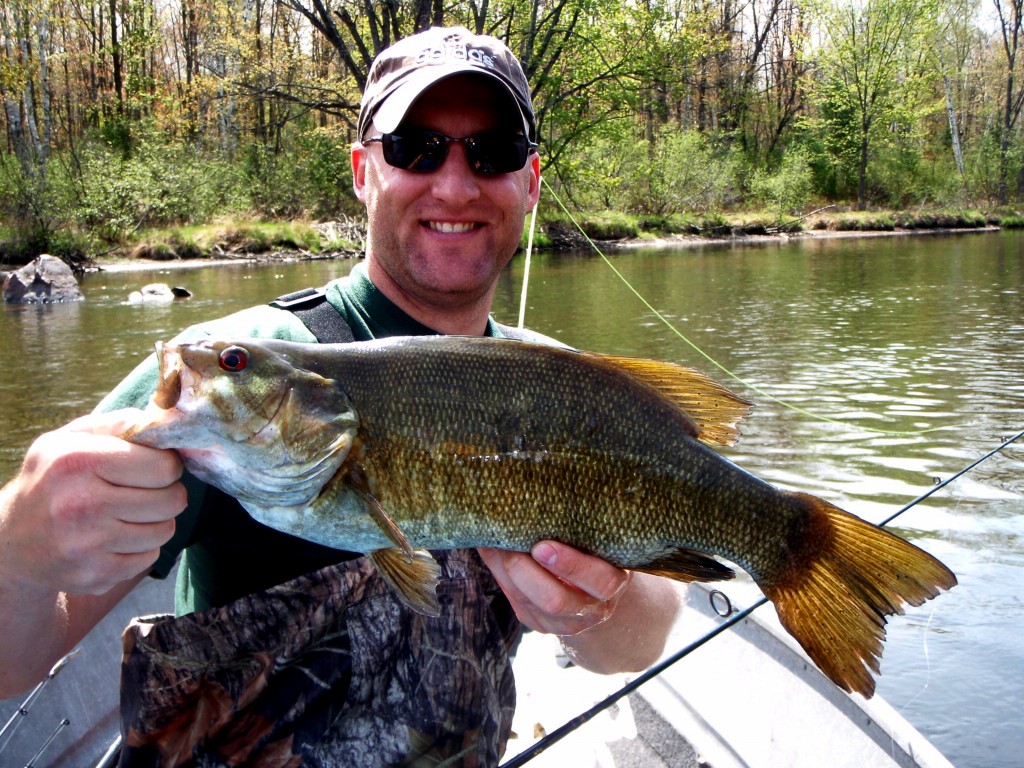
Seldom Studied Smallmouth Migrations
Roughly 84,000 miles of rivers and streams flow through the state of Wisconsin. Some of its larger waterways are inter-connected, and formed by, a series of reservoirs and flowages. Some of these river systems and flowages, such as the Flambeau, Chippewa, Wisconsin, Peshtigo, and Menominee River systems, contain superb populations of resident smallmouth bass. However, what population percentage of this species is comprised of migrant fish that travel back and forth between the river and its flowages?
Other than over-wintering movements, little is known about the spring migration patterns of smallmouth bass and the subject of their river travels altogether. Although mobile predators, most smallmouth bass populations studied by the Wisconsin Department of Natural Resources on lakes and rivers are not believed to be migratory for reasons other than refuge, cool water sanctuary and seasonal location. In many river systems, “Smallmouth bass are thought to spend most of their lives within five miles of where they hatched.” But if that’s the case, why aren’t I catching smallmouths anywhere within five miles from their spring spawning grounds in summer and later on in the season from most rivers I fish?
Current research is shedding new light on winter habitat and migratory behavior of smallmouth, finding variable behaviors between populations of these fish. On many river systems, namely the Flambeau and Wisconsin, some of its populations are sedentary year round residents, while a majority are nomadic, always on the move for long distances in spring for spawning and autumn for over-wintering.
Comparable to the migrant river walleye, whose river migrations have been extensively documented as they travel upwards of 10 to 20 miles in order to find suitable spawning grounds assuming dams aren’t impeding routes, recent radio telemetry studies have shown that smallmouth bass “Do undertake seasonal migrations greater than five miles, especially to reach spawning habitats in the spring, and to also reach over-wintering habitats in the fall.” Migrations of fish species between inter-connected flowages and rivers are common, but maximum distances in river miles without blockades of dams for smallmouth bass are unknown.
On the Wisconsin River sections I predominantly fish, I have navigable sections of free flowing river, upwards of 20 miles before eventually merging with a flowage. Following ice out, during the early season months of May and June, smallmouth bass are in sheer abundance in the habitat-rich rock and boulder pools where I run my float trips. Catching 30 to 50 fish in a day is possible from these textbook stretches. As the season progresses through summer, however, the population significantly dwindles to a less concentrated number, requiring floats of several miles through limited productive water and bountiful dead water in order to catch a respectable fish total. Then by fall majority of this river smallmouth population is no longer present in the river, having already migrated back into the deep still water flowages where they spend the winter, remaining in them until repeating the same upstream migration process again the following year.
Stream Observations
On the Wisconsin River system, clearly most of its smallmouth population undertakes a migration. But how far will they travel? Like walleyes, I know they will migrate at great distances, and it can be substantial if the downstream dams of flowages weren’t the end of the line. As it’s been happening in front of my eyes these last several years on the Wisconsin, I don’t need to conduct my own homemade telemetry studies in order to figure that one out. Under my nose for almost ten years, I just happened to finally realize it.
Where I fish in Oneida County, the Wisconsin River flows freely for upwards of 20 miles between a series of flowages and dams. In between this section of river are a few miles of pools with rock, boulder, and hard bottom areas with gradient from the head of a dam followed by several miles of dead, unproductive water leading the way into the downstream flowage. Based upon the dynamics of this pool the vast majorities of smallmouth are not sedentary. The fall and winter residents of the downstream flowage will migrate the full distance to spawn within several hundred yards of the upstream dam before returning to where they came from.
Smallmouth bass are more migratory fish species than anglers and state managers believe them to be. Although their seasonal movements are of interest to fishermen, managers don’t know for certain how far smallmouths would migrate without dams. Some studies by the American Fisheries Society suggest that “Northern reaches of the smallmouth bass range exhibit long distance migrations, upwards of 25 to 60 miles in length due to severe winters and extensive high water.” What nobody has yet researched or published are these long spawning migrations I’ve observed in spring.
Spring Habitat
Without question, smallmouth bass in spring are migrating for biological purposes. It’s possible that certain flowages on Wisconsin’s river systems aren’t conducive to spawning, but that would be purely uncommon. Most of the state’s flowages are middle aged habitat-rich waters remaining less than 100 years old, classified with abundant smallmouth fisheries. Because this spring migration has been repeating itself year-after-year on the upper Wisconsin, factors such as water level, current, forage, and refuge don’t seem to play a role as largely as spawning habitat.
On Wisconsin’s rivers, smallmouth bass spawn in late May through early June. Their nests are often built along the edges of current breaks and eddies. Noticeable habitats where nests are built include logs, boulders, and deeper shoreline cuts. Hard sandy bottoms mixed with gravel and loose rocks are common bottom types for excellent spawning grounds.
As mentioned, much of my productive spring locations on the Wisconsin River are comprised with long stretches of hard bottom with abundant rock, boulder, and wood cover that’s often separated by even longer stretches of dead water. It seems these rocky areas with boulder fields are usually located within the first five miles of any pool, before the dam. They are often in abundance with fish until they migrate back downstream or disperse throughout the river shortly after post spawn.
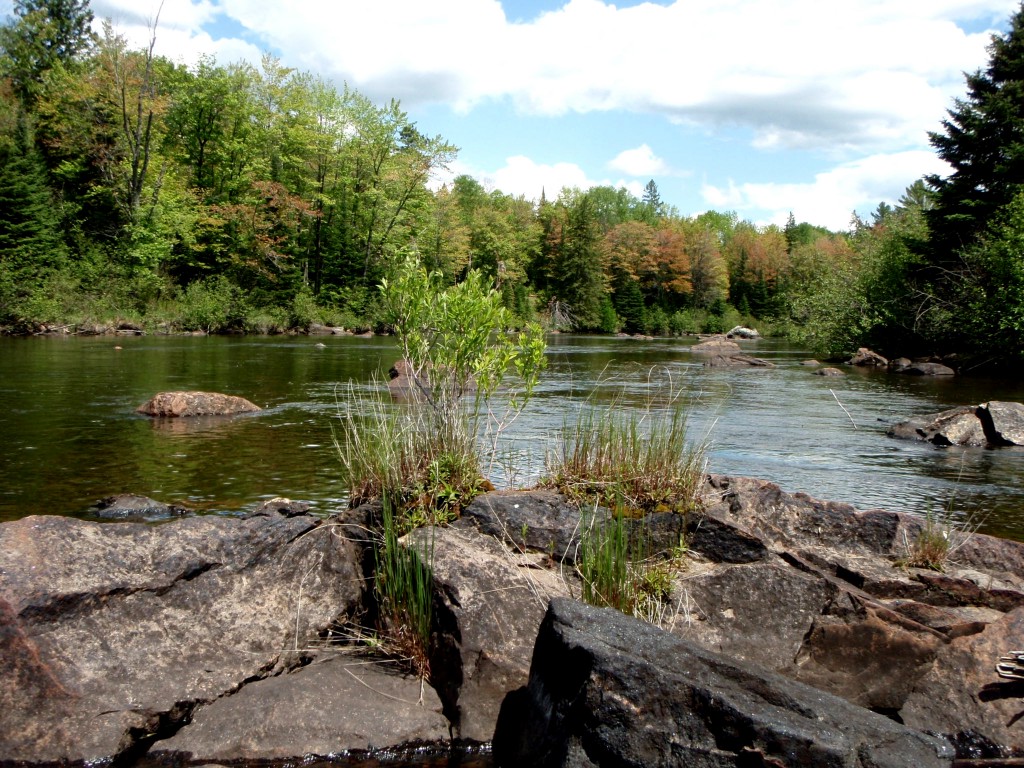
Fish + Location + Presentation = Success
A warm spring season is noticeably better than a cold season for fishing and prolonged success well into the month of June. Additionally, consistent water levels with moderate flow and exceptional clarity yield better results than high water.
The best river smallmouth fishing I’ve experienced in spring obviously depends upon timing and flexibility. Unfortunately, my river fishing calendar is based entirely upon previous history and trip logs dating back to May, 2005. Unless success is consistently experienced on certain weeks or specific dates and times, patterning the smallmouth calendar for a particular stretch of river is a difficult task. Knowing when and where to float a river on an annual basis is a long-term process and depends entirely upon your pool of river and when it historically fishes best. On the Wisconsin River, my period of fast action and high catch rates usually takes place beginning the third week of May and lasting through the third week of June. Weather, water level, and water temperatures obviously play instrumental roles in dictating whether the migrant smallmouth bass will be present or not, and when they will migrate back downstream.
Catching spring smallmouths during this short window of opportunity on the Wisconsin River is successful by wading the shallow rocky stretches of water. However, since the river is navigable for most watercraft in all of its pools throughout the state, it’s far more effective using a rugged boat that can withstand its treacherous boulders and jagged rock fields, preventing fish from spooking. The objective is to spend time covering water; to eliminate stretches of unproductive water until colonies of fish are found utilizing; and feeding in the hard bottomed areas.
Because this tale of spring migration isn’t focused on presentation, I will grant you access inside my small river bag of secrets. Crawfish patterned crankbaits, tubes, creature baits and soft plastics always get the first shot to catch fish. My secondary unit is then comprised of swim jigs and spinnerbaits, followed by soft jerkbaits. If all else fails, then the ever so simple twintail grub rigged with ball head jig solves it. Time it right on any river in the state and smallmouth bass will respond positively to almost any logical presentation. If fishing by boat, just toss in a few medium heavy fast action spinning rods and reels equipped with 8 lb line and baitcasting set-ups with 10 to 12 lb line. Don’t forget your Frabill landing net either, as chances are most fish you will be catching, photographing, and releasing will be large spawner size.
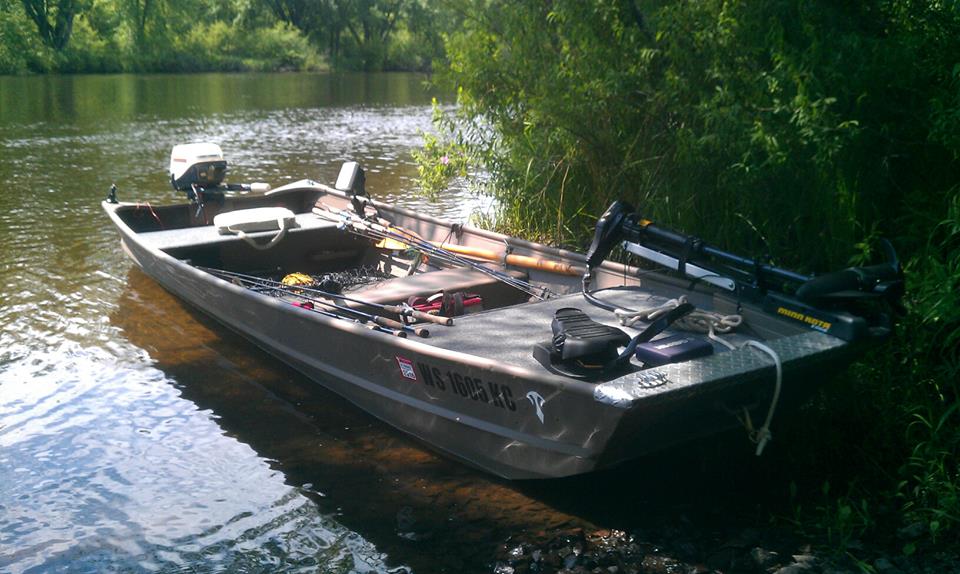
My Questions are Answered
Not all river smallmouth bass undertake spawning migrations as drastic as this, and not all of Wisconsin’s rivers and specific pools within the Flowage Belt behave the same. In different parts of the state, and even in other states, riverine populations have more complex behaviors relating to their spawning migrations and progressions downstream (sometimes gradual and other times sudden) to wintering habitat.
While migrations in spring have been documented to exist, but are only minor in writing, few anglers and even scientists realize how significant in length these migrations can potentially be. Thanks to my decade of spring fishing and learning the intricacies of my Wisconsin River pools, I believe I have unlocked a passage into the behavior and migrations of spring smallmouth bass, and being able to catch them year-after-year.
Stay mobile my friends and hit the rivers by boat when the fish move in each spring.
